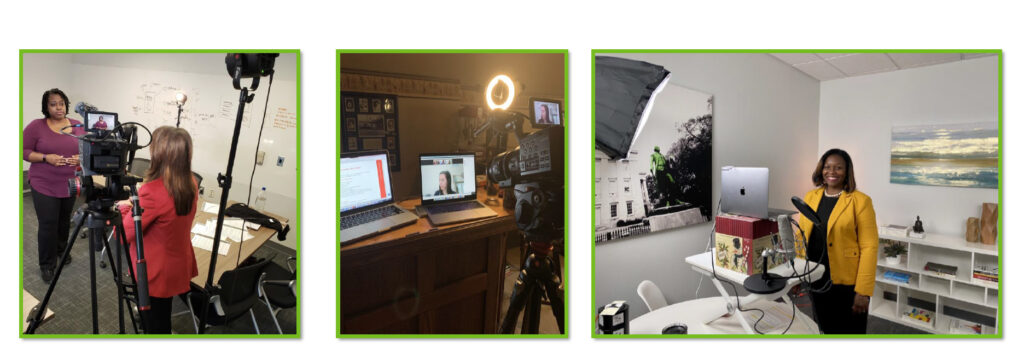Transform Even Reluctant Speakers Into Stars: Proven Strategies and Tactics to Use with Hospital Leaders
How UNC Health’s communications team prepares hospital executives for thought leadership.
// By Wendy Margolin //
 Among the most important currencies in health care is trust. Meanwhile, trust in leadership today is at an all-time low.
Among the most important currencies in health care is trust. Meanwhile, trust in leadership today is at an all-time low.
According to PwC’s 2022 Consumer Intelligence Series on Trust, 87 percent of executives think customers highly trust their companies. In reality, it’s roughly 30 percent.
That makes thought leadership from hospital executives a key method of cultivating stakeholder trust. The more leaders are accessible and knowable, the more employees and patients can trust the institutions they guide.

Sharon Delaney McCloud, director of corporate communications at UNC Health
At UNC Health, a major academic health system in North Carolina, the communications team recognizes that its leaders are called upon to be exceptionally visible. But that doesn’t mean they have the skills to be effective communicators.
“Our leaders have multiple advanced degrees. But we find that many of them, even 30 years into their career and with advanced degrees, have never taken a simple communications class because it doesn’t exist in many curricula,” says Sharon Delaney McCloud, director of corporate communications.
This knowledge led her, with Jamie Williams, director of executive communications, to develop a strategy to help the hospital’s leadership stand out as experts. Together, they poured their energy into developing content in their leaders’ voices and training those leaders to become outstanding communicators.
Shaping One Health Care Expert Into a Thought Leader
Becoming a thought leader takes time and talent. UNC Health CEO Wesley Burks, MD was willing to invest the time. Williams was tasked with preparing all of Burks’s executive communications. Burks is an expert in pediatric allergy and immunology and a humble leader. Williams knew he could help cultivate the leader’s talent.

Jamie Williams, director of executive communications at UNC Health
“That first year was all about building trust. To speak on behalf of a person, you have to understand them,” says Williams.
He spent hours following Burks to meetings to get to know his voice. He wrote notes for speeches and then recorded their delivery to analyze what Burks said and what he left out. “I would go back to my desk afterward like a football player listening to the tape repeatedly to pick up on what he ad-libbed on his own and the little expressions he liked to use.”
A big part of developing content for senior leaders is simply understanding how they work. For example, Burks wanted everything a week in advance so there’d be time to practice. “Whatever degree of success I’ve had in this role, I think probably 80 percent of it is that I hit that weekly deadline,” says Williams.
C-Suite Media Training
When Delaney McCloud came to UNC Health, she leaned on 20 years of experience as a television anchor to develop communication tools for hospital leaders. She knew from experience that the ability to perform on camera or on stage requires practice and some insider knowledge. “There’s no secret to this. It’s a matter of getting our leaders used to being on camera, not being afraid of it and understanding all the little tricks that make them feel more confident on camera,” she says.

Video training helps leaders get comfortable with being on camera and feel more confident.
She developed a strategy to support hospital leaders in preparing for presentations with everyone from the media to board members. Besides focusing on speaking skills, she shared tips on body language and presence:
- How are you sitting?
- If you’re standing, you will have better energy.
- Do you look stiff?
- Do you look comfortable?
- What are you doing with your hands?
Delaney McCloud’s key strategy is tip sheets she adds to the hospital’s intranet. They’re accessible to all staff and include topics like how to use a teleprompter and Zoom meeting tips on framing yourself and setting up a professional background and lighting.
C-Suite Thought Leadership in a Crisis
All the communications team’s efforts from UNC Health paid off when the pandemic hit, and every health care leader was called on to serve on the frontlines of care and communication. With support from Williams and Delaney McCloud, CEO Burks was prepared to show up on weekly video messages for internal and external audiences. “All of a sudden, we had to turn these leaders into prompter jockeys in the TV news business. That’s what it was like — the 5, 6, and 11 o’clock news,” says Delaney McCloud.
In the end, says Williams, those appearances strengthened hospital stakeholders’ trust in their leadership. “We got a great response from our teammates because they began to see [Burks] as that trusted leader we wanted to establish.”
Improving Communications Builds Better Leaders
Executives of every health care system are leaders, both internally and externally. They’re regularly called to address internal audiences, the board of directors, local groups, elected officials, chambers of commerce, and the media. For most leaders, communicating effectively with these stakeholders is a skill that can be taught and takes practice.
As health care leaders are pulled in various directions, it falls upon the marketing communications team to hold leadership accountable for prioritizing communication.
The marketing communications team at UNC Health designed a successful strategy to help its leadership show up in meaningful ways. Together, Williams and Delaney McCloud have been able to help UNC Health’s leadership stand out as experts, build trust, and support the communities they serve.
4 Tips to Prepare Health Care Leaders to Be Effective Communicators
- Every address is an opportunity to shine. At UNC Health, says Williams, they consider every stage the big stage. “We don’t like to have a hierarchy between a national keynote and a meeting of teammates in a town hall meeting. Those are both equal opportunities for leaders to shine. And we want to ensure they present themselves in the best way possible.”
- Build a story bank. UNC Health keeps a spreadsheet for executive leaders to list stories, along with the message and audience. Stories might be about life experience or job experience. They offer a strong starting point whenever the communications team needs to develop a speech.
- Design mock interviews. Delaney McCloud says they record leaders and then replay and dissect the videos together. Even with experienced leaders, the team meets with them every two months to prepare for upcoming speaking opportunities. “It’s in those moments of extreme discomfort that they realize this is a learning tool where they can learn to be better presenters, both in person and on camera.”
- Offer tip sheets. Add tip sheets for being a better communicator to your intranet. These can help everyone who has to speak in a leadership position or even at a Zoom meeting. “With repetitions, we saw that all of our leaders have just gotten better at communicating,” says Delaney McCloud.
As owner of Sparkr Marketing, Wendy Margolin helps busy health care marketing communications teams create more content. She’s on a mission to build a better medical web, one article at a time. Her favorite form of content is hospital brand journalism, which ties together her 20-year career in journalism, marketing, and health care.

